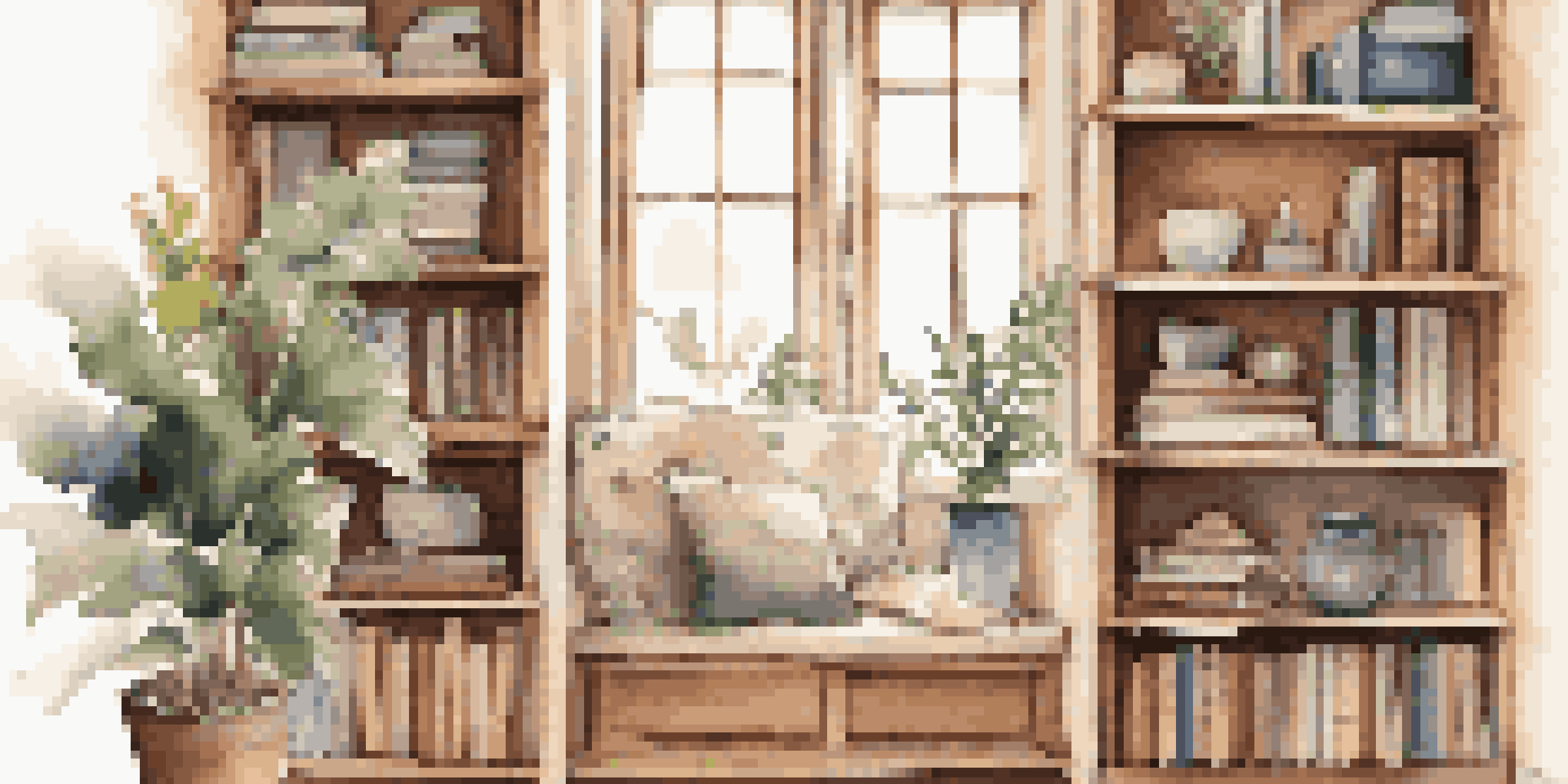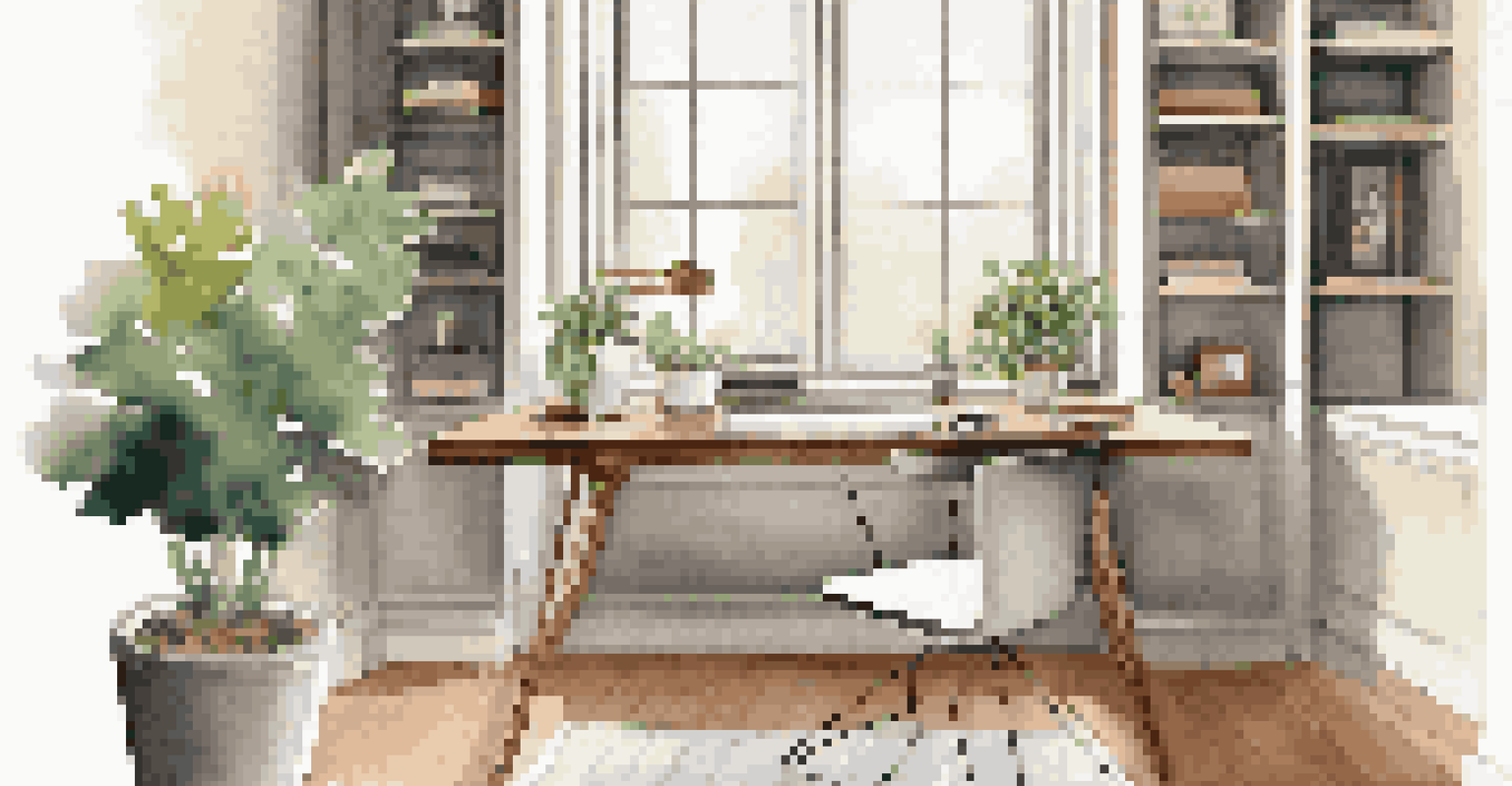Maximizing Space with Custom-Built Furniture Solutions

Understanding the Benefits of Custom-Built Furniture
Custom-built furniture is designed to fit your unique space and style. Unlike mass-produced options, it caters specifically to your needs, whether that’s maximizing a small room or creating a cohesive look throughout your home. This tailored approach not only enhances functionality but also adds a personal touch to your decor.
Furniture is meant to be functional, but it should also be beautiful and reflect who you are.
For example, imagine a small apartment where every square inch counts. A custom-built shelving unit can be crafted to fit snugly into an awkward nook, providing both storage and display space for books and decor. This kind of design ensures that you’re making the most of what you have, rather than settling for generic solutions.
Moreover, custom pieces can be made from high-quality materials that are more durable than typical store-bought furniture. When you invest in custom furniture, you’re not just getting a product; you’re investing in a solution that enhances your living environment and reflects your personality.
Identifying Your Space Needs Before Designing
Before diving into a custom furniture project, it’s crucial to identify your specific needs. Take a moment to assess your space: What functions do you need from your furniture? Are you looking for extra storage, a work area, or simply a stylish focal point? Understanding these requirements will guide your design process.

For instance, if you work from home, you might need a desk that fits your workflow and doesn’t dominate the room. A custom desk can be designed to incorporate storage for office supplies while still being compact enough to leave room for movement. This ensures that your work environment is both efficient and aesthetically pleasing.
Custom Furniture for Unique Spaces
Custom-built furniture is tailored to fit your specific space and style, enhancing both functionality and personal expression.
Additionally, consider the flow of your space. Measure your rooms carefully and visualize how your custom furniture will interact with existing elements. This way, you can create a harmonious and functional layout that feels open and inviting.
Choosing the Right Materials for Durability and Style
Selecting the right materials is vital for both the durability and aesthetic appeal of your custom furniture. Depending on your lifestyle, you might want materials that are easy to clean, resistant to wear and tear, or simply match your existing decor. Common choices include hardwood, plywood, and metal, each offering unique benefits.
Good design is about making other designers feel like idiots because that idea wasn’t theirs.
For example, hardwood is known for its longevity and classic appeal, making it a great choice for furniture that you want to last a lifetime. On the other hand, if you have kids or pets, a high-quality laminate could be more practical due to its resistance to scratches and stains. Choosing materials wisely ensures that your furniture remains functional and beautiful over time.
Don’t forget about finishes as well! A well-chosen finish can enhance the natural beauty of the material while also providing protection. Whether you opt for a sleek matte or a glossy sheen, the finish will play a significant role in the final look of your custom piece.
Collaborating with a Designer for Best Results
Working with a designer can elevate your custom furniture project to new heights. They bring a wealth of experience and creativity, helping you navigate the design process and make informed decisions. A designer can provide insights into current trends, practical solutions, and innovative ideas that you might not have considered.
For instance, if you have a specific vision in mind, a designer can translate that into workable plans. They are skilled at balancing aesthetics with functionality, ensuring your custom pieces not only look amazing but also serve their intended purpose efficiently. This collaborative approach can save you time and prevent costly mistakes.
Identify Needs Before Designing
Assessing your space requirements is crucial for creating custom furniture that effectively serves your lifestyle.
Furthermore, a designer can help you visualize the finished product through sketches or 3D renderings. This way, you can see how the piece will fit into your space, allowing for adjustments before any materials are cut or assembled.
Maximizing Small Spaces with Innovative Designs
Small spaces can be particularly challenging when it comes to furniture selection. However, custom-built furniture can turn these challenges into opportunities. By thinking creatively, you can design pieces that serve multiple functions, such as a bed that folds into the wall or a coffee table that doubles as storage.
For example, consider a narrow hallway where traditional furniture wouldn’t fit. A custom-built console table can be designed to be slim yet stylish, providing a place to drop keys and mail without overcrowding the space. These innovative solutions allow you to maximize every corner of your home.
Additionally, using vertical space is another effective strategy. Custom shelves that reach up to the ceiling can provide ample storage without taking up too much floor space. This approach not only keeps your belongings organized but also draws the eye upward, creating an illusion of more space.
Incorporating Personal Touches into Your Designs
One of the most rewarding aspects of custom-built furniture is the ability to infuse your personal style into each piece. Whether it’s through color, shape, or unique design elements, your furniture can truly reflect who you are. This personalization transforms your space from a generic setting into a home filled with character.
For example, if you have a passion for travel, you might incorporate elements from your adventures into your furniture design. A coffee table made from reclaimed wood found on a trip or a bookshelf painted in colors inspired by your favorite destination can become conversation starters while showcasing your interests.
Collaborate for Successful Designs
Working with a designer can elevate your custom furniture project by providing expert insights and ensuring aesthetic and functional balance.
Additionally, consider adding bespoke features that cater to your hobbies or routines. A custom nightstand with built-in charging ports for your devices or a crafting table with specialized storage can enhance your living experience, making your space not just beautiful but also functional.
Budgeting for Custom Furniture: What to Consider
When it comes to custom furniture, budgeting is an essential step that can greatly influence your choices. It’s important to have a clear understanding of your financial limits before getting started. This will help you prioritize the features that matter most to you and avoid overspending on unnecessary extras.
For instance, while high-quality materials come at a premium, they often provide better longevity, which can save you money in the long run. Consider investing in key pieces that will see the most use, while opting for simpler designs in other areas. This balanced approach allows you to maintain quality without breaking the bank.

Additionally, don’t forget to factor in potential costs for design consultations and installations. While these may seem like extra expenses, they can ultimately result in a better final product. A well-planned budget will give you peace of mind and help ensure that your custom furniture project stays on track.